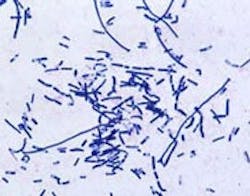Scientists Develop Advanced Sensors for Biological Agent Detection
Developing effective detectors for biological agents is a priority for an increasing number of scientists at companies and government groups worldwide.
Because of some innovative work, protein and antibody chips have come to the forefront in DNA-based techniques to identify biological agents. With devices based on these chips, scientists have discovered a way to eradicate the need to initially remove DNA from pathogens. Eliminating this step speeds detection and, in the process, moves scientists closer to satisfying a critical requirement of these devices.
"The current thrust for both physical and chemical analysis is to solve the time and reagent problems and provide broad-spectrum instruments that can be used in military and civilian situations," says Technical Insights Analyst James Smith.
Without clear direction, the integration of new technologies into a comprehensive set of methods and instruments for future detection may prove to be costly and slow. For instance, antibody-based detectors in weapons take 30 to 45 minutes for the capture-to-identification process and are reagent intensive.
Because of the war on terrorism, the need for fast, accurate and reliable biological and chemical sensing is critical. Developing sensor systems for continuous, real-time detection of biological agents is the ultimate aim. Instrument systems will be the workhorses behind these systems.
Biosensors and chemical sensors are being integrated with microfluidics technology for use in point detection of agents. However, trace analysis with these devices is still time consuming, slowed by the arduous need for sampling and sample preparation.
Novel microfluidic devices are being developed using a special strain of E. coli, which exudes large amounts of potassium even when exposed to small amounts of oxidative toxins. An optical system built into the chip detects the potassium and, accordingly, the oxidative toxins.
"Homeland security can benefit from this analysis because many chemical warfare toxins are oxidative," says Smith. "Not only can drinking water systems be protected this way, but disastrous direct attacks on wastewater treatment, especially for large cities, can be prevented."
Several challenges exist. For example, industry participants need to gear up for the development of detectors for specific, known agents. Further, it may not be easy to quickly characterize and identify the latest strains and toxins.
"Advances in Chemical and Biological Detection for Security," a new analysis by Technical Insights, a business unit of Frost & Sullivan, notes that rapid detection is essential to respond effectively to a biological and chemical attack, especially when there is a perpetual threat of assault using weapons of mass destruction. Governments have been actively promoting research and development of new technologies for security applications, sensors, equipment and analytical process.
Source: Frost & Sullivan
